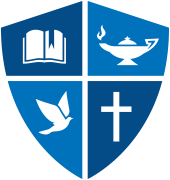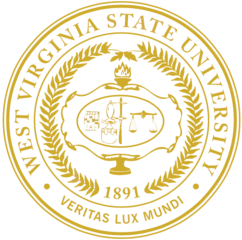
TheAmerican University is a private federally chartered research university in Washington, D.C. Its main campus spans 90 acres on Ward Circle, mostly in the Spring Valley neighborhood of Northwest D.C. AU was chartered by an Act of Congress in 1893 at the urging of Methodist bishop John Fletcher Hurst, who sought to create an institution that would promote public service, internationalism, and pragmatic idealism. AU broke ground in 1902, opened as a graduate education institution in 1914, and admitted its first undergraduates in 1925. Although affiliated with the United Methodist Church, religious affiliation is not a criterion for admission.

Gallaudet University is a private federally chartered university in Washington, D.C., for the education of the deaf and hard of hearing. It was founded in 1864 as a grammar school for both deaf and blind children. It was the first school for the advanced education of the deaf and hard of hearing in the world and remains the only higher education institution in which all programs and services are specifically designed to accommodate deaf and hard of hearing students. Hearing students are admitted to the graduate school and a small number are also admitted as undergraduates each year. The university was named after Thomas Hopkins Gallaudet, a notable figure in the advancement of deaf education.

The George Washington University is a private federally chartered research university in Washington, D.C. Chartered in 1821 as Washington, D.C.'s first university by the United States Congress, GW is one of six universities in the United States with a congressional charter.

Tuskegee University is a private, historically black land-grant university in Tuskegee, Alabama. It was founded on Independence Day in 1881 by the Alabama Legislature.

Northwest University is a private Christian university in Kirkland, Washington. The university offers associate, baccalaureate, master's, and doctorate degrees through its College of Arts & Sciences, School of Business and Management, School of Education, Mark and Huldah Buntain School of Nursing, College of Ministry, and College of Social and Behavioral Sciences. It has a satellite campus in Salem, Oregon.

Towson University is a public university in Towson, Maryland. Founded in 1866 as Maryland's first training school for teachers, Towson University is a part of the University System of Maryland. Since its founding, the university has evolved into eight subsidiary colleges with over 20,000 students. Its 329-acre campus is situated in Baltimore County, Maryland eight miles north of downtown Baltimore. Towson is one of the largest public universities in Maryland and still produces the most teachers of any university in the state.

Edward Miner Gallaudet, was the first president of Gallaudet University in Washington, D.C. from 1864 to 1910.

Alabama State University is a public historically black university in Montgomery, Alabama. Founded in 1867, during the Reconstruction era, it was one of about 180 "normal schools" established by state governments in the 19th century to train teachers for the rapidly growing public common schools. It was one of 23 established to train African Americans to teach in segregated schools. Some of the 180 closed but most steadily expanded their role and became state colleges in the early 20th century and state universities in the late 20th century. ASU is a member-school of the Thurgood Marshall College Fund.
Trinity Washington University is a private Catholic university in Washington, D.C. The university was founded as Trinity College by the Sisters of Notre Dame de Namur in 1897 as the nation's first Catholic liberal arts college for women. Trinity was chartered by an Act of Congress on August 20, 1897. It became Trinity Washington University in 2004.

West Virginia State University (WVSU) is a public historically black, land-grant university in Institute, West Virginia. Founded in 1891 as the West Virginia Colored Institute, it is one of the original 19 land-grant colleges and universities established by the second Morrill Act of 1890, which evolved as a diverse and inclusive campus. Following desegregation, WVSU's student population slowly became more white than black. As of 2017, WVSU's student body was 75% white and only 8% African-American.
The University of the District of Columbia David A. Clarke School of Law is the law school of the University of the District of Columbia, a public historically black land-grant university in Washington, D.C. It is named after David A. Clarke and was established in 1986 when, in response to a local grassroots campaign, the Council of the District of Columbia decided to take over the Antioch School of Law, whose parent institution Antioch University had decided to close it in the face of increasing financial problems. The school was formally merged into the University of the District of Columbia in 1996.

Paul Laurence Dunbar High School is a historically black public secondary school located in Washington, D.C. The school was America's first public high school for black students.

North Cleveland Park is a neighborhood in the Northwest quadrant of Washington, D.C.

Normal School for Colored Girls established in Washington, D.C., in 1851 as an institution of learning and training for young African-American women, especially to train teachers.

Julia Evangeline Brooks was an incorporator of Alpha Kappa Alpha Sorority, Incorporated, the first sorority founded by African-American women. The sorority has continued to generate social capital for nearly 100 years.

Antioch School of Law was a law school in Washington, D.C. which specialized in public advocacy. The school now operates as the University of the District of Columbia David A. Clarke School of Law (UDC-DCSL).

The Charles Sumner School, established in 1872, was one of the earliest schools for African Americans in Washington, D.C. Named for the prominent abolitionist and United States Senator Charles Sumner, the school became the first teachers' college for black citizens in the city and the headquarters of its segregated school system for African American students. It currently houses a small museum, a research room, art exhibits, and the archives of the District of Columbia Public Schools.
The University of the District of Columbia Community College (UDC-CC) is an open-enrollment, public community college located in Washington, D.C. It operates the associate degree, Certificate, Continuing Education and Workforce Development programs that are offered by the University of the District of Columbia.
Ronald Francis Mason Jr. is an American lawyer and university administrator, serving as the ninth president of the University of the District of Columbia (UDC). He took office in July 2015. This is Mason's third presidential appointment. He was previously chief executive officer at the Southern University System of Louisiana (2010-2015) and Jackson State University (2000-2010). Before his administration at Jackson State, Mason held several executive appointments over a 17-year tenure at Tulane University, including general counsel, vice president for Finance and Operations and senior vice president and general counsel.


















